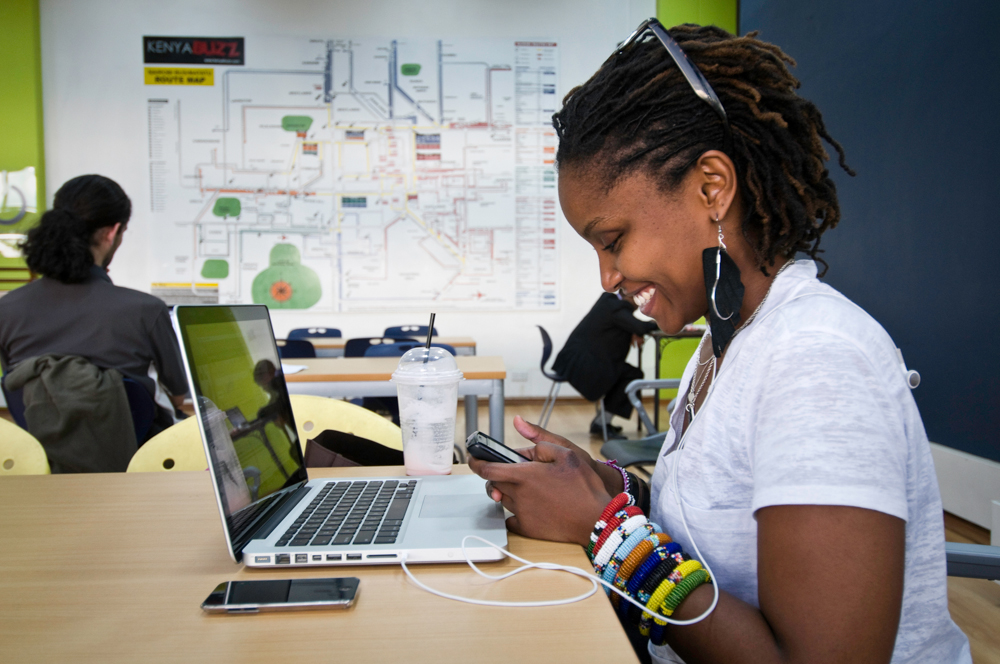Trends in Technology-Aided Family Planning Among Young People in Kenya

Image credit: iHub/United Nations Development Programme, courtesy of flickr.
In Kenya, like in other parts of the world, young people face different structural challenges in the pursuit of accessible, affordable, quality, equitable, and acceptable family planning methods to support them in deciding when they want children and how many children (spacing) they wish to have. Despite the government identifying family planning as a key strategy in the pursuit of the national development agenda, many cultural, socioeconomic, religious, or other barriers still stand in the way of effective access to family planning.
Traditionally, gaining access to accurate contraceptive information and methods posed challenges due to religious dictations, societal constructs, and taboos; constrained financial capability; and geographical boundaries. However, with increasing access to and integration of technology into people’s daily activities, a significant transformation has been witnessed, evidenced by how young people seek reliable information and engage with family planning resources. Despite this paradigm shift, a lot of misinformation still needs to be replaced by correct and verified information in digital spaces. This is a key strategy to achieving the desired outcomes for global family planning.
Barriers to Family Planning Information and Methods
As it stands, one of the biggest hindrances to the effective uptake of family planning is the regular shortage of commodities, especially in public hospitals, which serve a majority of the Kenyan population. Additionally, inflated out-of-pocket expenditures hamper effective health-seeking for a population of about 55 million citizens, with about 35% living below the $2.15 poverty line. Unfortunately, none of the regulated insurances, private or public, covering less than 30% of the whole population, has catered to family planning in their packages.
In June 2024, the Government of Kenya, through the National Treasury and Economic Planning docket, reduced the 2024/25 health budget by Ksh. 14.2 billion (~US$110 million) from the previous year’s allocation, from KSh. 141.2 billion to Ksh. 127 billion. This subsequently handed a Ksh. 500 million budget cut—50% less than what was projected—for family planning commodities and services, including demand creation and capacity strengthening. Additionally, the disbursement of the remaining figure also stands in jeopardy, as civil society members regroup to advocate for reinstatement of the initial figure and the subsequent disbursement from the treasury to the Kenya Medical Supplies Authority (KEMSA), the government’s main procurement authority for health supplies.
With a youthful population of over 80% aged 35 and below, the supply of health commodities has faced acute shortages over the years due to lack or insufficiency of finances, and corruption. Coupled with a shrinking donor and funding space after Kenya was upgraded to a lower middle-income country, the regular shortages of family planning commodities have been a persistent issue over the years. Even though donations by existing development partners such as the United Nations Population Fund (UNFPA), the Foreign, Commonwealth & Development Office (FCDO), and the United States Agency for International Development (USAID) to provide a variety of commodities through the Ministry of Health, the supply still falls way short of the demand.
The exclusion of certain populations in program interventions to serve the family planning needs of diverse groups in Kenya has also slowed the success of family planning uptake. The most recent Health Cabinet Secretary, Susan Nakhumicha, agreed that the country needs to target interventions to meet the family planning health seekers in hard-to-reach areas including those in arid and semi-arid lands.
Additionally, some religions and cultures have restricted the use of family planning for youth. While a rising number of young people are identifying themselves as non-religious or atheist, youth who are still religious may have different perceptions of the acceptability of contraceptive use in their religious doctrines. In addition, some cultural practices such as early marriage, polygamy, and wife/widow inheritance may play a role in not using family planning. Furthermore, many cultures in Kenya still believe that children are blessings, and the more they have, the more status they are accorded.
The advent of technology that birthed e-health through the World Wide Web, computers, and smartphones has also presented a wave of misinformation, as much as they are widely used to get helpful information on services, commodities, locations of health facilities, medical experts, and diagnoses. To optimize e-health, the Kenyan Government introduced the Kenya National eHealth Policy (2016-2030), which also aims to regulate the information and communication guiding health online.
Changing Family Planning Landscape with the Uptake of Technology
Recent research shared by the Communications Authority of Kenya highlights significant internet penetration in the country, with about 48 million regular internet subscriptions recorded and 66 million SIM usage. The number (130.5% device penetration) has been attributed to multiple devices owned including mobile smartphones, tablets, computers, and other personal digital assistants. Competition between mobile network providers has resulted in generally affordable Internet bundles, helping to improve access to the technology for a wider share of the population including youth.
According to the 2024 Audience Measurement and Industry Trends Report from the Communications Authority of Kenya, Facebook and WhatsApp top the list of the most used social media among young Kenyans, with a score of 49.4% for Facebook and 47.0% for WhatsApp of all social media users. The popularity of these two can be pegged on the demographics and the utility that they provide. For example, Facebook gives pages, groups, and business profiles, whereas WhatsApp gives channels, groups, and an opportunity to be linked with other social media as a direct communication method to business owners. Aside from these, YouTube occupies the third spot with 29.5% of user mentions. Notably, YouTube offers educational content, entertainment, and a platform for young creators. TikTok takes the fourth position at 23.0%. Its short-form video format remains popular with younger users who enjoy creating and consuming bite-sized content. Instagram, with a performance percentage of 13.3% of user mentions, caters to a more visual generation with its focus on photos and stories.
With more and more young people accessing mobile devices and onboarding technology, it opens up the possibility of utilizing mobile technology as a way to disseminate important family planning information and services, especially among young girls and women. The upward push of technological systems, mobile applications, and telemedicine has democratized access to family planning resources and has empowered young people in Kenya to look for facts discreetly, connect with associated healthcare professionals remotely, and access essential reproductive health services at their convenience. Through mobile technology, youth can find answers to pertinent issues with anonymity, interact in virtual discussions, and gain access to aid services related to reliable family planning materials. They can also stay updated with information on new and popular methods and possible side effects and benefits of each. This shift toward online sources has inspired a paradigm shift in how younger people design and pursue their family planning goals, ensuring that young people can make informed choices. Despite the gaping dangers of possible misleading information if ingested from unreliable sources, young people have become more adept at tracking reliable sources of information online. Thus, harnessing the ability of social media engagements through the available platforms gives a promise of reaching and teaching a much wider target audience, eventually improving the knowledge of the average young Kenyan about sexual and reproductive health and rights and family planning.
Online platforms and groups serve as beneficial spaces for youth to have discussions, try to find guidance, and share reviews associated with popular family planning options. These structures offer a sense of community and support, permitting young family planning service seekers to connect with peers going through similar situations. Moreover, structured social media outlets offer secure and confidential surroundings through one-on-one private and anonymous counseling, wherein young people can ask questions and access dependable information from trained specialists.
Additionally, the emergence of telemedicine startups like Daktari Africa and MYDAWA Health represents a transformative shift in healthcare accessibility, especially for youth in Kenya. Through the fast-growing space of telemedicine, health service seekers can now seek advice from healthcare providers remotely, confidentially, and comfortably, breaking down boundaries of stigma and accessibility that may have previously hindered access to family planning commodities and services. By utilizing digital channels that include video calls or chat structures, young people can find relevant recommendations and prescriptions and get access to contraceptive methods without the need for in-person visits to healthcare facilities. This not only enhances privacy and confidentiality but also addresses logistical barriers, such as transportation and waiting times. As telemedicine reaches more and more people, it holds the capacity to revolutionize family planning habits among young people in Kenya, ensuring that everybody has the constitutional right of access to the highest attainable reproductive health standards (Article 43, Constitution of Kenya, 2010) without any grounds for discrimination (Article 27, Constitution of Kenya, 2010).
What Prospects Does the Future Hold?
The dynamic growth of artificial intelligence (AI) and machine learning in health and medicine bears a significant prospect for revolutionizing the scope of virtual health solutions, including within the field of family planning. These technological advancements are poised to pressure the improvement of customized digital health in policy and practice that caters to the needs of young health seekers in Kenya.
In the context of family planning, personalized tech-based health solutions can provide various benefits like supplying personalized information for family planning methods based on user factors inclusive of age, health background, lifestyle, and reproductive wishes, helping people exercise their ability to make informed family planning decisions. However, given the evolving nature of AI, it is advisable to fact-check information to prove its credibility. Technology can also be leveraged to provide convenient reminders for family planning appointments and interactive instructional content tailor-made to individual desires. Just like some apps can track menstrual cycles, they can also be designed to keep crucial information about the life cycle of a choice of family planning (e.g., when IUDs need to be changed depending on the type). In addition, virtual reality simulations may be used for contraceptive counseling, allowing healthcare providers to be part of a virtual, immersive, and interactive experience for people searching for information on family planning methods.
Overall, customized virtual health solutions can empower individuals to improve their reproductive health and make informed decisions about family planning. By harnessing the capabilities of technology, including AI and machine learning, these solutions can provide targeted guidelines, predictive insights, and behavior change communication.




